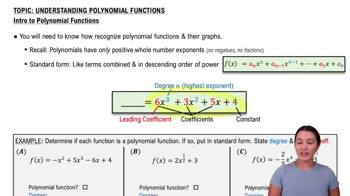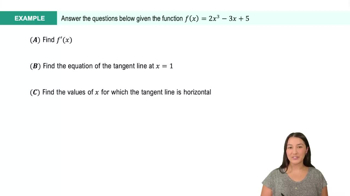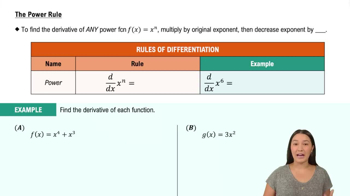Table of contents
- 0. Functions7h 52m
- Introduction to Functions16m
- Piecewise Functions10m
- Properties of Functions9m
- Common Functions1h 8m
- Transformations5m
- Combining Functions27m
- Exponent rules32m
- Exponential Functions28m
- Logarithmic Functions24m
- Properties of Logarithms34m
- Exponential & Logarithmic Equations35m
- Introduction to Trigonometric Functions38m
- Graphs of Trigonometric Functions44m
- Trigonometric Identities47m
- Inverse Trigonometric Functions48m
- 1. Limits and Continuity2h 2m
- 2. Intro to Derivatives1h 33m
- 3. Techniques of Differentiation3h 18m
- 4. Applications of Derivatives2h 38m
- 5. Graphical Applications of Derivatives6h 2m
- 6. Derivatives of Inverse, Exponential, & Logarithmic Functions2h 37m
- 7. Antiderivatives & Indefinite Integrals1h 26m
- 8. Definite Integrals4h 44m
- 9. Graphical Applications of Integrals2h 27m
- 10. Physics Applications of Integrals 2h 22m
3. Techniques of Differentiation
Basic Rules of Differentiation
Problem 3.32
Textbook Question
Derivatives Find the derivative of the following functions. See Example 2 of Section 3.2 for the derivative of √x.
g(x) = 6x⁵ - 5/2 x² + x + 5
 Verified step by step guidance
Verified step by step guidance1
To find the derivative of the function g(x) = 6x⁵ - \frac{5}{2}x² + x + 5, apply the power rule to each term separately. The power rule states that if f(x) = xⁿ, then f'(x) = n*xⁿ⁻¹.
Start with the first term, 6x⁵. Using the power rule, the derivative is 5 * 6x⁴, which simplifies to 30x⁴.
Next, consider the term -\frac{5}{2}x². Again, apply the power rule: the derivative is 2 * (-\frac{5}{2})x¹, which simplifies to -5x.
For the term x, recall that the derivative of x is simply 1, since x is x¹ and applying the power rule gives 1*x⁰ = 1.
The derivative of a constant, such as 5, is 0, because constants do not change and thus have no rate of change.
 Verified video answer for a similar problem:
Verified video answer for a similar problem:This video solution was recommended by our tutors as helpful for the problem above
Video duration:
3mPlay a video:
Was this helpful?
Key Concepts
Here are the essential concepts you must grasp in order to answer the question correctly.
Derivatives
A derivative represents the rate of change of a function with respect to its variable. It is a fundamental concept in calculus that provides information about the slope of the tangent line to the curve of the function at any given point. The derivative can be computed using various rules, such as the power rule, product rule, and quotient rule, depending on the form of the function.
Recommended video:

Derivatives
Power Rule
The power rule is a basic differentiation rule used to find the derivative of functions in the form of f(x) = x^n, where n is a real number. According to this rule, the derivative f'(x) is given by n*x^(n-1). This rule simplifies the process of differentiation for polynomial functions, making it easier to compute derivatives quickly.
Recommended video:
Guided course

Power Rules
Polynomial Functions
Polynomial functions are mathematical expressions that consist of variables raised to non-negative integer powers, combined using addition, subtraction, and multiplication. The general form is f(x) = a_n*x^n + a_(n-1)*x^(n-1) + ... + a_1*x + a_0, where a_n are coefficients. Understanding polynomial functions is crucial for applying differentiation techniques, as they are commonly encountered in calculus problems.
Recommended video:

Introduction to Polynomial Functions

 3:59m
3:59mWatch next
Master Derivatives of Linear Functions with a bite sized video explanation from Callie
Start learningRelated Videos
Related Practice







